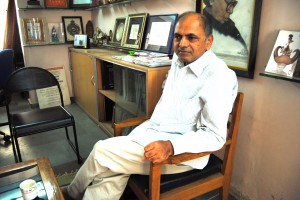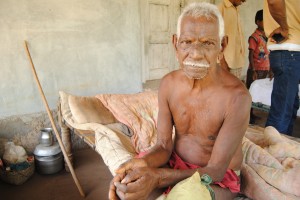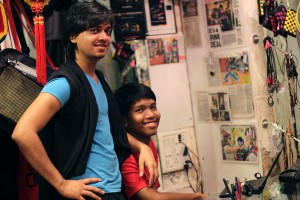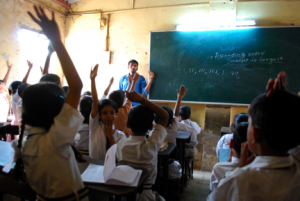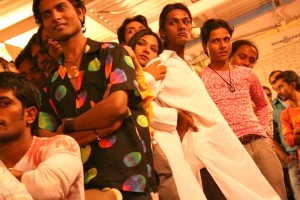By Ashley Hopkinson (class of 2012)
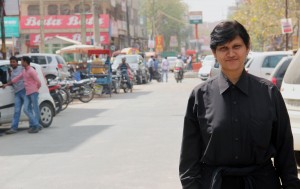
Angela Cardoz
DELHI, India, April 2010—India’s growing ranks of millionaires want a new kind of security and status symbol—a female bodyguard. That desire is allowing a small group of women to work alongside men and live their dreams.
Even under the blazing heat of the midday sun in the far, northwestern Delhi suburb of Dwarka, Angela Cardoz looks relaxed in an all-black outfit, a collared shirt, pants and a light sweater, wrapped around her waist and loosely tied in a knot around the front. She looks like a ninja, standing out among the swirling colors of traditional Indian clothing — beautiful saris colored in pale yellows, bright greens and dazzling hues of red.
Cardoz, 37, is used to standing out, used to be being stared at.
Here in Dwarka, she has just stepped out of a large, black SUV. With her are three other women. Two are slim and tall enough to be models, their long, black hair pulled back from their faces. Another is short and muscular with shoulder-length hair. The fourth is Cardoz, the Indian ninja, not particularly tall, but muscular, her dark, black hair cut short and layered, the longest layer barely touching the top of her ears.
Cardoz walks with confident strides to the main office of her employer, Secura Security, an orange, four-storey building in the center of the city. Even in her office, they stare at her.
Cardoz and her three colleagues are female bodyguards, part of a new India, where women try to assert their rights, live their dreams and venture into positions and jobs that were once the exclusive domain of men.
Cardoz is from Goa, one of India’s smallest states, known for its beaches, Roman Catholic churches and enduring cultural influence—in song, dance and architecture—of its former colonial masters, the Portuguese. Goa is as different from New Delhi, Cardoz’s home for the last two years, as Maine is from Mexico.
It didn’t take long for Cardoz to realize that Delhi, where she lives with an aunt, was the best place to pursue her dream of being a bodyguard. Even with data suggesting that the crime rate in Goa has increased 59 percent over the last five years, India’s capital still snags top spot for being one of the most dangerous states in the country, especially for women.
Two of every three women have faced sexual harassment last year in Delhi, a city of 16 million, according to a United Nations and government backed survey, which included results found by Jagori, a grassroots organization that aims to raise awareness about women safety and gender equality. The local media often call Delhi the rape capital of India.
“It’s unfair that people think ‘oh she’s a woman she’s weak and she can’t defend herself so I can just come and try to touch her and trouble her,’” said Cardoz, one of 20 women at Secura’s Dwarka office. “I’m very happy to be in this job, my dream has come true.”
Cardoz is one of a few hundred women opting for careers as female bodyguards in leading security companies like Secura Security in Delhi and Tops Security in Goregaon, Mumbai. Tops Grup oversees 14 security companies under its brand including TOPS Security Limited, one of the largest security companies in the country. The division Tops Grup has more than 200 female bodyguards on staff from areas of the country including Haryana and Uttar Pradesh. The women are usually from lower-middle-class class families, officials said, sometimes driven by economic need.
Management officials said they began training women because of the demand to hire women in a country where the status of women in general is low, though that is changing. India is one of six countries with female only train cars. They started, in part, because of instances of eve teasing—a colloquial term used in India to describe public sexual harassment of women, which is commonplace in most public areas including, toilets, streets and crowded metro commuter trains. Cities in Indonesia, Brazil, Russia and Japan have women-only commuters cars for similar reasons. It may seem like a mild example of why someone would need a bodyguard, but Cardoz said pervasive sexual harassment of women is one reason their job has become increasingly necessary.
Sitting in a corner office of the Secura Security headquarters, Cardoz recounted the events of her first day of work, two years ago.
Cardoz was nervous, though her first task was simple: accompany the new boss to the mall while she shopped. Her boss was a wealthy, middle-aged woman from Delhi, whose name and occupation Cardoz said she could not reveal. That day, she kept her eyes on her boss, but she also focused some of her attention on a group of 20-something-year old young men, who had made of a game of harassing women as they entered the mall, she said. As her boss approached the mall entrance, Cardoz said the harassment from the men intensified. And she realized then that her client had become the young men’s new center of interest.
“Hey listen, it’s better you don’t do this,” Cardoz recalled saying as she stood face to face with the most belligerent young man in the group, “One day you will have a family and if someone does this to your family, how would you feel?”
In that particular situation, talking to the young men was enough to get them to stop, Cardoz said. If they had continued to act hostile, “I would have used more force,” she added. Like many female bodyguards Cardoz is trained for confrontation. Whether her response is verbal or physical depends on the level of threat, she said.
Cardoz’s client, whose identity she cannot reveal, is a part of India’s fast-growing rich, who can afford 20,000 ($ 377) to 50,000 ($ 943) rupees a month for protection. It is impractical for the majority of the population in a country where the average annual income, in 2011, was 82,000 rupees ($ 1,547).
The amounts vary based on the skills and experience of the guards. Those who are former police officers or army soldiers rank highest on the salary scale. Those like Cardoz, who came in with no such experience, rank lower on the salary scale.
Most industry spokespersons acknowledged that the relatively new business is trending toward being a status symbol for the wealthy rather than a means of crime prevention. The average client is a celebrity or business tycoon who wants female bodyguards for his wife and college-age daughters.
In some cases, the client is a wealthy female executive who would request the service for business trips out of town. The world’s second-fastest growing economy after China, India has spawned at least 50 of the world’s wealthiest U.S. dollar billionaires over the last ten years, according to Forbes Magazine. India is ranked number 19 on a separate Forbes global ranking of millionaires.
Womens’ rights organizations said that while female bodyguards are a novel idea that upholds their ideals of women empowerment, it is not something accessible to the masses.
Morever, female bodyguards may not address even one percent of the issue of gender insensitivity and violence against women, said activists of women’s organizations like Jagori and All India Democratic Women’s Association (AIDWA).
“Yes, they (female bodyguards) might ensure your safety. But again it is an exclusive service and it is not a service that is commonly accessible to all,” said Prabhleen, a women’s rights advocate with Jagori in Delhi.
Prableen, who asked that her last name not be used, said it takes a long time for things to become common in India and bodyguarding is not a likely exception.
Sudha Sundararaman, the general secretary of AIDWA, said they have done little or no investigation into the increase of women into that field of work, but support women being in a position equal to their male counterparts.
“However, the whole concept of personal bodyguards is something that should not be necessary here,” said Sundararaman. “There needs to be a situation set up where the direction is not toward more females hiring bodyguards, but should be toward a general social atmosphere where people are safe.”
What women in India need is support, Prableen said. And that may include hiring a bodyguard, but for the general population, there needs to be an atmosphere that encourages women to speak up. Prableen said it’s not as much about Indian women being assertive as about that assertiveness being resented.
“The picture of a woman is seen good or bad,” Prableen said. “We need to accept that women in Delhi and women in India have that burden of preserving themselves as good women.”
Part of that preservation includes knowing one’s place, she said.
“In India it is this idea that you have to be good so you don’t speak up,” Prableen said. “Young girls are told by their mothers, fathers and even friends that if you speak against violence, you are calling for more attention and more violence.”
In 2004, Jagori, in existence for 24 years, began its Safe Delhi campaign, hoping it would encourage more women to take self-defense classes and publicly share their stories about violence. They organized mass protests, programs and candle light marches for their cause.
Prableen said it’s difficult for women to ask for help because they risk being blamed.
Prableen said consciously or unconsciously many victims of violence “take the guilt on themselves,” by feeding into the claim that they were dressed inappropriately or were sending body signals that teased their attacker.
Following a gang rape incident the in the Indian city Gurgaon, located about 18 miles south of New Delhi, local administration instituted an 8 p.m. curfew for female employees. Women across India created a firestorm on social media websites like Facebook and Twitter. Similar policies were suggested for women working in call centers across the country. Those positions require that employees work from 6 p.m. to 6 a.m., to make up the time difference and field calls from places as far away as the United Sates.
That’s where bodyguard agency directors say they play an integral role—not in changing the way society views women being mistreated, but by giving women a chance to defend other women, who now have the chance to hire them in order to feel safe.
In general, women are seen as a vulnerable part of the population, Cardoz said, and being able to protect them is one reason she loves her job. She is able to empower women to speak up, while also protecting them, she said.
Secura Security Director AK Singh said like any other business they work based on client demand. About three years ago more clients began to inquire about female bodyguards to protect their wives and children, and Singh said they seized the opportunity.
“We have some clients who are celebrities and they need some safety for their women, kids and young college girls,” he said. “ When clients started to approach us we started our women commander services,” Singh said, using the internal company term used to refer to female agents.
They responded by starting a training class that lasts six to eight weeks to prepare women who are eager to fight violence, he said, adding that, the demand for female bodyguards started to pick up in the latter part of 2011. Singh said his best guess about the sudden interest in female bodyguards is that people are beginning to see the value in having someone protect their wives and children, who can also blend in well with the structure of the family, without attracting excess attention.
“See, the woman has got some sense of responsibility, and she can handle the situation in a better manner than a man because women have to face some (of the same) problems clients (face),” Singh said. “This is a man’s arena, but still they are performing and doing their duties on the same level as the men.”
Tops Grup in Mumbai has had a similar service, except on a considerably larger scale. It’s been three years and the operation of a female bodyguard unit known as “Tops Angels,” is successful.
Brigadier M. I. Jaisinghani, a former army officer, is the director of training at Tops Grup Training Academy, located in 20 places across India, staffed by 100 instructors.
Jaisinghani said that they train their female bodyguards in martial arts and combat for 21 days before they are assigned to clients. They also have mandatory academic security training classes.
“We toughen them up by making them do these things every day,” Jaisinghani said. “We train them in such a manner that they are motivated to give their life for the client.”
The typical female bodyguard in India has to be physically fit and keep herself that way, graduate at least 10 th standard pass, the equivalent of 10th grade education, be between 20 to 35 years old and willing to be on call for work 24 hours, seven days a week. Exceptions are rare, he said.
Most bodyguards at Tops Grup are hired on yearly renewable contracts. The minimum contract is for a month. Secura Security allows clients to hire bodyguards by the hour, day or year. The company also absorbs the cost of training but Tops Grup security either have to pay a 6000 rupee ($ 113) training fee upfront or have it deducted from their salaries.
The typical female security guard earns roughly 7000 rupees ($ 132) a month and female bodyguards make an average of 40,000 rupees ($ 754) a month, 5,000 ($ 94) more than the average male bodyguard in the company.
But a safe India for the modern-day Indian woman seems like an ideal that is far off, said Mahuwa Tyagi, a bodyguard for two years. Tyagi is tall and slim, her long, black hair neatly pulled into a low ponytail as she talked at the Secura office in Dwarka.
The difference between the two women is that Tyagi was used to confrontation and combat at her former job as an officer with the Central Reserve Police Force (CRPF), a paramilitary unit that is deployed to trouble-spots across India. Trained by the CRPF and Secura Security, her services do not come cheap, by Indian standards. She can earn anywhere from 40,000 ($ 754) to 50,000 rupees ($ 943) a month.
Tyagi lives in a guest home on the property of her client, a non-resident Indian, protecting his family, primarily a college-age daughter, while caring for her own— a win-win situation, she said. Tyagi is married and can now spend time with her four-year old daughter, something she could not do in her previous job.
Like Cardoz, Tyagi said her family is pleased with her job, especially when she explains that she is protecting a family in the same way she used to protect people as a paramilitary officer.
“It’s the same,” she said. “With the police I was protecting the country. Here, I’m protecting a family.”
Tyagi said although everyone does not agree with her career choice the general response is often encouraging.
“Obviously we will give a sense of empowerment (…) in India everybody thinks that there is specific work for women only, but also, if you say you’re doing this kind of thing they feel proud,” she said. “They actually are, like wow, that kind of reaction is what we get.”
